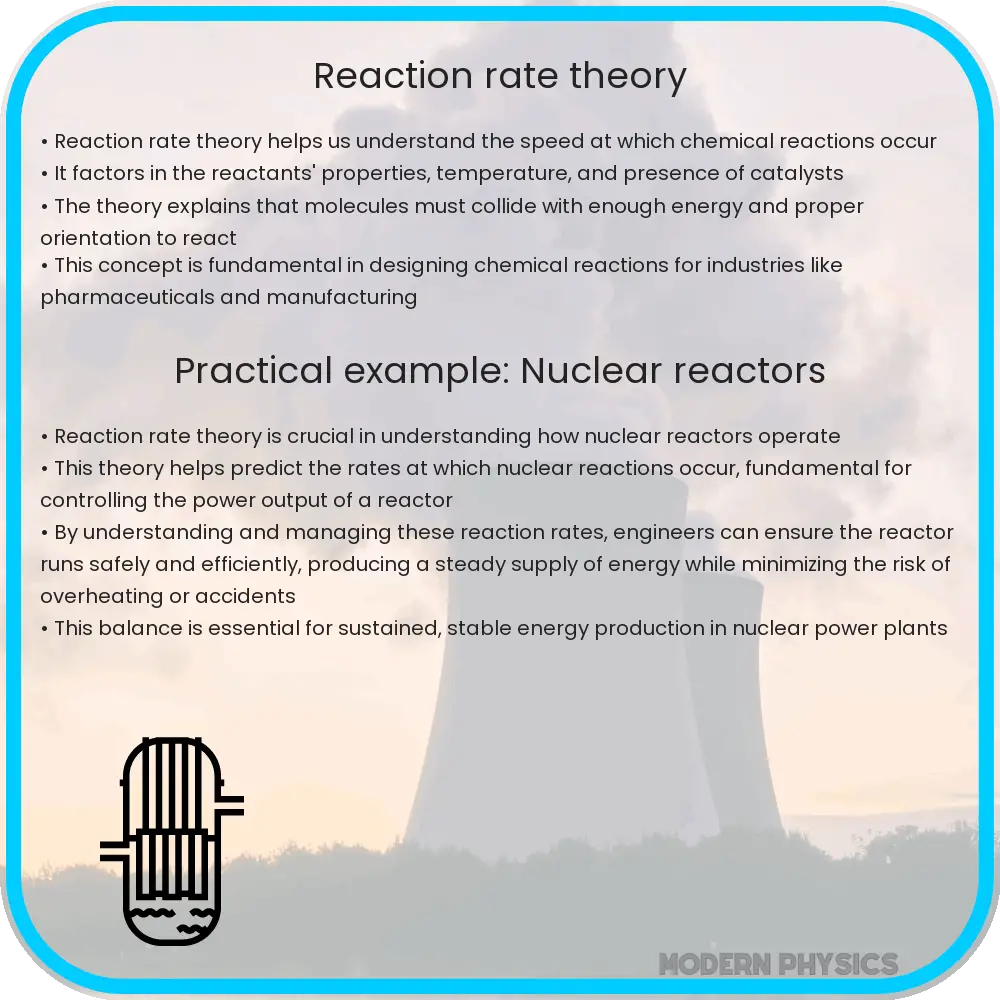Explore the fundamentals and applications of Reaction Rate Theory in chemistry, covering kinetics, dynamics, and real-world implications.

Understanding Reaction Rate Theory
Reaction Rate Theory, also known as Transition State Theory, plays a crucial role in the field of chemical kinetics. It provides a microscopic explanation of how chemical reactions occur and why reaction rates vary for different reactions. This theory is fundamental in understanding the dynamics and kinetics of chemical processes, making it essential for chemists, material scientists, and engineers alike.
The Dynamics of Chemical Reactions
At its core, Reaction Rate Theory delves into the dynamics of molecules during a chemical reaction. It focuses on the transition state – a high-energy, unstable arrangement of atoms that exists momentarily as reactants transform into products. The theory posits that the rate of a reaction is proportional to the number of times reactants cross this transition state barrier.
Kinetics: The Study of Reaction Rates
Kinetics, a significant aspect of Reaction Rate Theory, involves studying the speed or rate at which chemical reactions proceed. Factors like temperature, pressure, concentration of reactants, and the presence of catalysts dramatically influence these rates. The Arrhenius equation, given by k = A e-(Ea/RT), where k is the rate constant, A the frequency factor, Ea the activation energy, R the gas constant, and T the temperature, quantitatively describes the effect of temperature on the rate of a chemical reaction.
Applications of Reaction Rate Theory
The implications of Reaction Rate Theory are vast and diverse. In the pharmaceutical industry, it aids in understanding the kinetics of drug degradation and the design of stable formulations. In materials science, it helps in predicting the lifespan and stability of materials under various conditions. Environmental science benefits from this theory by modeling the rate of pollutant degradation and understanding atmospheric chemistry.
This theory also has significant applications in catalysis – the process of increasing the rate of a chemical reaction by adding a substance known as a catalyst. By understanding the transition states and energy barriers, scientists can design more efficient catalysts for industrial processes, leading to increased productivity and reduced energy consumption.
Advanced Topics in Reaction Rate Theory
Beyond its basic applications, Reaction Rate Theory extends into more complex areas like non-equilibrium thermodynamics and quantum mechanics. For instance, in the study of enzyme kinetics, the theory helps in understanding how enzymes lower the activation energy of biological reactions, a fundamental concept in biochemistry. Quantum mechanics, on the other hand, offers a deeper insight into the electronic and structural changes during the transition state, especially in reactions involving light or very fast processes.
Computational Chemistry and Reaction Rate Theory
In the era of digital technology, computational chemistry has emerged as a powerful tool in studying reaction mechanisms and kinetics. Computer simulations based on Reaction Rate Theory enable scientists to predict reaction pathways and rates without conducting actual experiments. This approach is invaluable in areas like drug discovery and the design of new materials, where experimental studies can be time-consuming and expensive.
Environmental and Industrial Relevance
Environmental chemistry greatly benefits from Reaction Rate Theory. It aids in predicting the fate of chemicals in the environment, assessing risks, and developing strategies for pollution control. Industrially, this theory is essential in chemical engineering for the design and optimization of reactors, ensuring efficient and safe chemical processes.
Challenges and Future Directions
Despite its widespread application, Reaction Rate Theory faces challenges, particularly in accurately predicting rates for complex, multi-step reactions. Future research is likely to focus on integrating more sophisticated models and computational methods to overcome these limitations. The integration of machine learning and AI in predictive models is another exciting frontier, potentially revolutionizing how we understand and manipulate chemical reactions.
Conclusion
Reaction Rate Theory stands as a cornerstone in the understanding of chemical kinetics and dynamics. Its applications span across various fields, from environmental science to pharmaceuticals, and continue to grow with advancements in technology. As research progresses, this theory will undoubtedly unveil deeper insights into the microscopic world of atoms and molecules, furthering our ability to control and utilize chemical reactions for the betterment of society and the environment.
